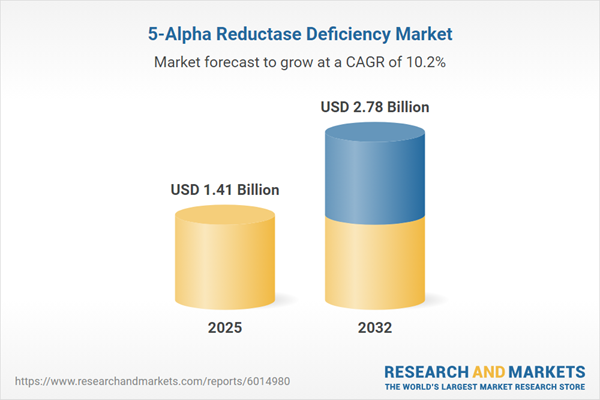Speak directly to the analyst to clarify any post sales queries you may have.
The 5-Alpha Reductase Deficiency Market is moving through a phase of dynamic change, driven by healthcare innovation, evolving regulatory demands, and new clinical strategies. This comprehensive research is designed for industry leaders seeking actionable intelligence on market positioning, operational resilience, and technology adoption in a rapidly shifting therapeutic landscape.
Market Snapshot: Strong Growth Potential in a Regulated Environment
The 5-Alpha Reductase Deficiency Market grew from USD 1.28 billion in 2024 to USD 1.41 billion in 2025. It is expected to continue growing at a CAGR of 10.17%, reaching USD 2.78 billion by 2032. A combination of scientific progress in androgen metabolism, expanding clinical adoption, and supply chain complexity are shaping decision priorities for manufacturers, payers, and healthcare systems. This market’s sustained growth is anchored by innovative drug formulations, expanded care settings, and ongoing responses to regulatory and tariff impacts.
Scope & Segmentation: In-Depth Coverage of Market Dimensions
- Treatment Type: Dutasteride; Finasteride
- Formulation: Capsule (Extended Release, Immediate Release); Solution (Concentrated, Standard); Tablet (Extended Release, Immediate Release)
- Route of Administration: Oral; Topical
- Distribution Channel: Hospital Pharmacy (Private, Public); Online Pharmacy (Branded Portal, Third-Party Marketplace); Retail Pharmacy (Chain, Independent)
- End User: Clinics (Dermatology, Urology); Home Care (Caregiver-Administered, Self-Administered); Hospitals (General, Specialty)
- Age Group: Adult; Geriatric; Pediatric
- Region: Americas (North America: United States, Canada, Mexico; Latin America: Brazil, Argentina, Chile, Colombia, Peru); Europe, Middle East & Africa (Europe: United Kingdom, Germany, France, Russia, Italy, Spain, Netherlands, Sweden, Poland, Switzerland; Middle East: United Arab Emirates, Saudi Arabia, Qatar, Turkey, Israel; Africa: South Africa, Nigeria, Egypt, Kenya); Asia-Pacific (China, India, Japan, Australia, South Korea, Indonesia, Thailand, Malaysia, Singapore, Taiwan)
- Covered Companies: Thermo Fisher Scientific Inc., F. Hoffmann-La Roche AG, Illumina, Inc., Danaher Corporation, Agilent Technologies, Inc., QIAGEN N.V., PerkinElmer, Inc., Bio-Rad Laboratories, Inc., Fulgent Genetics, Inc., Invitae Corporation
Key Takeaways for Senior Decision-Makers
- Therapeutic innovation is focused on targeting 5-alpha reductase isoenzymes to improve efficacy and patient outcomes across diverse clinical indications and severity profiles.
- Formulation technology, including oral extended-release and enhanced topical solutions, is advancing to support compliance, personalized dosing, and localized therapy.
- Digital health platforms and telemedicine services enable remote adherence tracking and treatment optimization, facilitating individualized care pathways.
- Strategic partnerships, especially between innovator firms, biopharma players, and contract manufacturers, are driving rapid product development and supply chain adaptation.
- Segmentation by distribution channel, end user, and age group is critical to addressing unique market access barriers and supporting commercial success in underserved demographics.
Tariff Impact: Navigating Regulatory and Trade Policy Shifts
Recent United States tariff measures have escalated input costs for key pharmaceutical ingredients, increasing complexities in production and procurement. As a result, stakeholders are reexamining sourcing models, reinforcing domestic manufacturing, and renegotiating supplier agreements to ensure product availability despite evolving trade policies. Tariff exclusions and diversified supplier relationships are focal strategies for sustained operational agility in the face of global supply chain risks.
Methodology & Data Sources
This study utilizes a mixed-methods process, starting with expert interviews among clinicians, payers, and opinion leaders to generate deep qualitative insights. Structured questionnaires ensure full coverage of evolving clinical and market trends. Systematic secondary research reviews peer-reviewed studies, patents, regulatory filings, and company reports. Data triangulation and rigorous cross-validation practices uphold research accuracy and reliability.
Why This Report Matters
- Delivers integrated qualitative and quantitative analysis to inform strategy in the 5-Alpha Reductase Deficiency Market.
- Identifies risks and opportunities arising from ongoing regulatory updates, digital transformation, and technological innovation.
- Equips decision-makers with deep segmentation and regional insights to guide investment, patient access, and operational planning.
Conclusion
Industry leaders must adapt to changes in technology, supply chain logistics, and regulatory demands. This report offers practical intelligence to inform capital allocation, partnership initiatives, and go-to-market strategy in a continuously shifting market environment.
Additional Product Information:
- Purchase of this report includes 1 year online access with quarterly updates.
- This report can be updated on request. Please contact our Customer Experience team using the Ask a Question widget on our website.
Table of Contents
3. Executive Summary
4. Market Overview
7. Cumulative Impact of Artificial Intelligence 2025
Companies Mentioned
The companies profiled in this 5-Alpha Reductase Deficiency market report include:- Thermo Fisher Scientific Inc.
- F. Hoffmann-La Roche AG
- Illumina, Inc.
- Danaher Corporation
- Agilent Technologies, Inc.
- QIAGEN N.V.
- PerkinElmer, Inc.
- Bio-Rad Laboratories, Inc.
- Fulgent Genetics, Inc.
- Invitae Corporation
Table Information
| Report Attribute | Details |
|---|---|
| No. of Pages | 191 |
| Published | October 2025 |
| Forecast Period | 2025 - 2032 |
| Estimated Market Value ( USD | $ 1.41 Billion |
| Forecasted Market Value ( USD | $ 2.78 Billion |
| Compound Annual Growth Rate | 10.1% |
| Regions Covered | Global |
| No. of Companies Mentioned | 11 |









